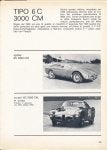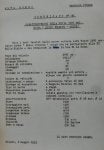I think perhaps the pursuit of names, or tipo id, is obscuring the actual facts of the car you may be trying to define.
As has been established here, there was indeed a 6C 3000CM spider, derived of a coupe. But, as I think you might be implying there was a 3 liter Disco Volante.
Now once again we have to look at the use of the term Disco Volante at the time and since. While the term was coined for the Touring based 2 liters, because of its side-wind aero shape influencing the whole. The basis of this was the tube frame beneath, upon which Touring created the shape. It is the use of this tube frame that was adopted, or adapted, for use with the CMs that gave name longevity to the new Colli cars.
A further point of association, and interest, was the use of the 6C 3000 engine as a starting point. Now let’s look at this. The 6C 3000 was a prototype of 1948 for a Berlina. Now this makes perfect sense in the fact that the predominance of 6C 2300 – 2500 sales were four doors, sedans, or Berlinas if you prefer. Only one of these was built, Alfa seeing the post war market need for a more economical bread and butter car, the 1900 Berlina.
This said, with this new 3 liter 6C engine in hand, a high performance version was developed during 1949. For the 1950 Mille three aero Berlinetta bodied comp cars were built. Two had a comp 6C 2500 engine (145hp) and one had the modified 6C 3000 engine (190hp) placed in it. The 3 liter car was named Gran Sport 6C 3000 C50.
It is interesting to note that development of these cars coincided with Colombo’s return to Alfa after having designed and developed what would become the signature V12 for Ferrari. Colombo’s return resulted in Alfa’s full throated commitment to competition. (See 158 – 159 development & success).
Now it is interesting to note that one of the 6C 2500 Competizioni mentioned was ready for the 1949 Mille, and very nearly won driven by Franco Rol, placing third.
For 1950 it would be Rol in his ’49 car, Fangio in the newer 6C 2500 Comp, and Sanesi in the C50 (Competitzione 1950). They were seen as the only real competition for Ferrari with their 195s & 340s. Fangio took third. Rol was sidelined with brake problems. Sanesi had plug problems early on and pushed too hard later on in compensation, crashing, severely, between Rovigo and Ferrara.
Now, why this visit back here? Because in looking for contemporaneous source material I came across this on the book self: It from an old issue of Auto Sport review, the granddaddy of NYC based sport car publications. John Fitch was technical editor.
OK, the image files didn't seem to load, so here's a link to the site with the article:
Velocity Group
In Conclusion:
This I believe is your Disco Volante 3000 spider. Notice the bore and stroke, this is the prototype 3 liter’s dimensions. The only engine built to that bore and stroke. So they took the Comp 3 liter and put it in one of the Discos for a bit of testing. How does this relate to the CM? Well the translation of CM is Competizione Maggiorata, or Updated for competition. So the Discos were a prototype studiesy of frame and aero, with the experimental wet-liner 2 liter and the CMs were the 5 cars based upon the C50 engine and built for business.
So nomenclature of individual models eludes when speaking of competition department experiments of so few example produced.












